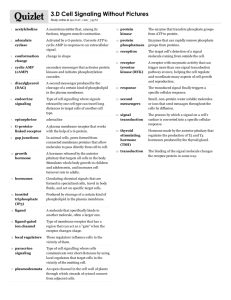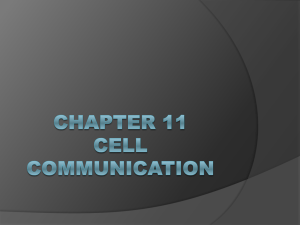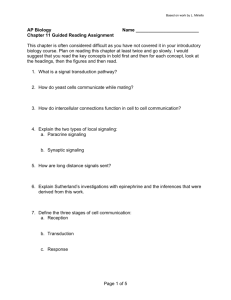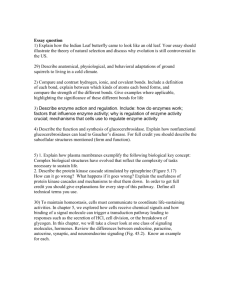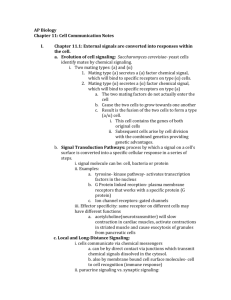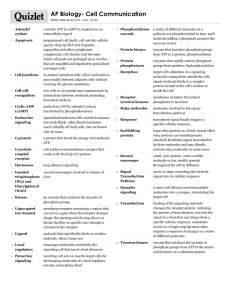KEY - CH 11 RG (powerpoint)
advertisement
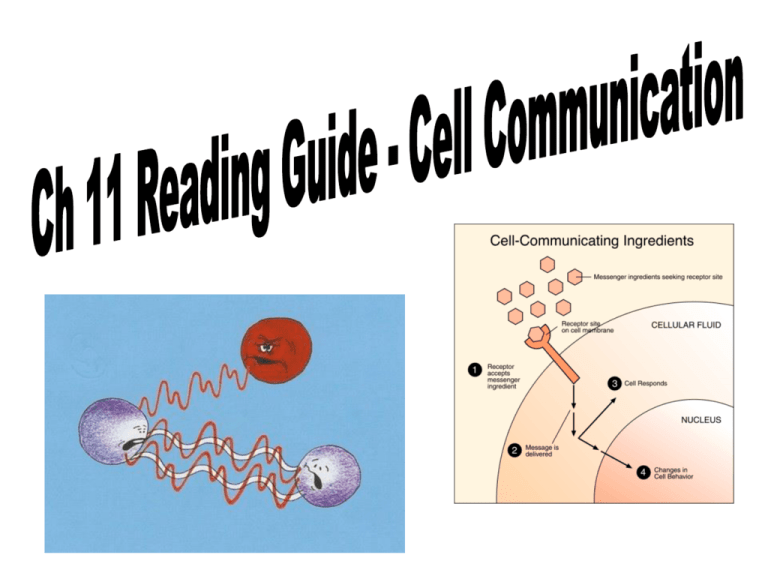
1) What is a signal transduction pathway? ● the process by which a signal on a cell’s surface is converted into a specific cellular response (a series of steps) 2) How do yeast cells communicate while mating? ● chemical signaling ● 2 mating types: a and α (alpha) -type “a” cells secrete “a” factor -type “α” cells secrete “α” factor ● the factors bind to receptors on the other; the 2 mating factors cause the cells to grow toward each other and fuse 3) How do intercellular connections function in cell to cell communication? ● both plant and animal cells have cell junctions (gap junctions in animal cells; plasmodesmata in plant cells) that, where present, directly connect the cytoplasms of adjacent cells ● signaling substances dissolved in the cytoplasm can freely pass between adjacent cells 4) Explain the two types of local signaling: A) Paracrine signaling ● a secreting cell acts on nearby target cells by releasing molecules of a local regulator (i.e. growth factor) into the extracellular fluid 4) Explain the two types of local signaling: B) Synaptic signaling ● a nerve cell releases neurotransmitter molecules into a synapse, the narrow space between the transmitting cell & the target cell 5) How are long distance signals sent? ● Long distance signals are sent by chemicals called HORMONES. ● specialized endocrine cells secrete hormones into body fluids,often the blood. ● hormones may reach virtually all body cells, but will only attach to target cells with the specific receptor molecule 6) Explain Sutherland’s investigations with epinephrine and the inferences that were derived from this work. ● discovered that epinephrine stimulates glycogen breakdown by activating a cytosolic enzyme, glycogen phosphorylase. ● this only worked when epinephrine was applied to intact cells ● INFERENCE: epinephrine does not act on the enzyme directly; and the cell membrane is somehow involved in transmitting the signal 7) Define the three stages of cell communication: A) Reception: ● the target cell’s detection of a signal coming from outside the cell ● a chemical signal is detected when it binds to a cellular protein (usually a membrane protein) 7) Define the three stages of cell communication: B) Transduction: ● the binding of the signal molecule changes the receptor protein in some way… ● the signal is converted to a form that can bring about a specific cellular response 7) Define the three stages of cell communication: C) Response ● the transduced signal finally triggers a specific cellular response 8) What is a ligand? ● a small molecule that specifically binds to a larger one ● a signal molecule behaves as a ligand 9) What is special about intracellular receptors – hint think of the structure of the cell membrane and how this relates? ● intracellular receptors are typically proteins dissolved in the cytosol or nucleus of a target cell ● may become activated with the binding of the signal molecule ● the activated form may then respond or cause a change (i.e. enter the nucleus and turn on specific genes) 10) Label this diagram of a steroid interacting with an intracellular receptor. (Fig. 11.9) 11) Where would you expect most water soluble messengers to bind and why? ● would most likely bind to receptors on the outside surface of the plasma membrane; ● they are water-soluble & probably too large to pass through the cell membrane 12) What is a G-protein-linked receptor? (see fig. 11.7) ● a plasma membrane receptor that works with the help of a G-protein ● the G-protein is attached to the cytoplasmic side of the membrane and acts as a switch that is on (GTP) or off (GDP) 13) (see fig. 11.7, p. 211 captions): (overview): A G-protein-coupled receptor is a cellsurface transmembrane receptor that works with the help of a G protein, a protein that binds the energy-rich molecule GTP . (1) When GDP is bound to the G protein, the G protein is inactive. The receptor and G protein work together with another protein, usually an enzyme . 13) (see fig. 11.7, p. 211 captions): (2) When the appropriate signaling molecule binds to the extracellular side of the receptor, the receptor is activated and changes shape . Its cytoplasmic side then binds an inactive G protein, causing a GTP to displace GDP . This activates the G protein. 13) (see fig. 11.7, p. 211 captions): (3) The activated G protein leaves (dissociates from) the receptor, diffuses along the membrane, and then binds to an enzyme , altering the enzyme’s shape & activity . Once activated, the enzyme can trigger the next step, leading to a cellular response . 13) (see fig. 11.7, p. 211 captions): (4) The changes in the enzyme and G protein are only temporary because the G protein also functions as a GTPase enzyme – in other words, it then hydrolyzes its bound GTP to GDP. Now inactive again, the G protein leaves the enzyme, which returns to its original state. The GTPase function of the G protein allows the pathway to shut down rapidly when the signaling molecule is no longer present. 14) What is a KINASE (i.e. a protein kinase)? ● an enzyme that catalyzes the transfer of a phosphate group from ATP to another molecule 15) (see fig. 11.7, p. 212 captions): (overview): Receptor tyrosine kinases belong to a major class of plasma membrane receptors characterized by having enzymatic activity. The part of the receptor protein extending into the cytoplasm functions as a tyrosine kinase, an enzyme that catalyzes the transfer of a phosphate group from ATP to the amino acid tyrosine on a substrate protein. One receptor tyrosine kinase complex may activate ten or more different transduction pathways and cellular responses. The ability of a single ligand-binding event to trigger so many pathways is a key difference between receptor-tyrosine kinases and G protein-coupled receptors . 15) (see fig. 11.7, p. 212 captions): (1) Before the signaling molecule binds, the receptors exist as individual units referred to as monomers. Each monomer has an extracellular ligand-binding site, an α helix spanning the membrane, and an intracellular tail containing multiple tyrosines . 15) (see fig. 11.7, p. 212 captions): (2) The binding of a signaling molecule (such as growth factor) causes 2 receptor monomers to associate closely with each other , forming a complex known as a dimer (dimerization). 15) (see fig. 11.7, p. 212 captions): (3) Dimerization activates the tyrosine kinase region of each monomer; each tyrosine kinase adds a phosphate from an ATP molecule to a tyrosine on the tail of the other monomer. 15) (see fig. 11.7, p. 212 captions): (4) Now that the receptor is fully activated , it is recognized by specific relay proteins inside the cell. Each such protein binds to a specific phosphorylated tyrosine, undergoing a resulting structural change that activates the bound protein. Each activated protein triggers a transduction pathway , leading to a cellular response . 16) (see fig. 11.7, p. 213 captions): (overview): What triggers a ligand-gated ion channel to open/close? when a signaling molecule binds as a ligand to the receptor protein What then passes through the channel once it is open? Specific ions, such as Na+ or Ca2+, pass through the channel receptor 16) (see fig. 11.7, p. 213 captions): **study and read the captions for parts 1-3 of this diagram! (conclusion): How do nerve cells make use of ligand-gated ion channels? neurotransmitter molecules released at a synapse between 2 nerve cells bind as ligands to ion channels on the receiving cell, causing the channels to open; as ions flow in/out, an electrical signal is generated and passed down the receiving cell…a nerve impulse! 16) (see fig. 11.7, p. 213 captions): How is a voltage-gated ion channel different? these channels are controlled (opened / closed) by electrical signals (not ligands / chemical signals) . 16) DIAGRAM: Ligand-gated ion channel 17) (see fig. 11.10, p. 215 captions): (overview): Summarize what occurs in a phosphorylation cascade: a series of different molecules in a pathway are phosphorylated in turn, each molecule adding a phosphate group to the next one in line . (1) A relay molecule activates protein kinase 1 . 17) (see fig. 11.10, p. 215 captions): (2) Active protein kinase 1 transfers a phosphate from ATP to an inactive molecule of protein kinase 2, thus activating this 2nd kianse. (3) Active protein kinase 2 then catalyzes the phosphorylation (& activation ) of protein kinase 3. 17) (see fig. 11.10, p. 215 captions): (4) Finally, active protein kinase 3 phosphorylates a protein that brings about the cell’s response to the signal. (5) Enzymes called protein phosphatases (PP) catalyze the removal of the phosphate groups from the proteins, making them inactive & available for reuse. 18) What are protein phosphatases and why are they so important? ● enzymes that remove phosphate groups from proteins ● they help to rapidly turn off a signal-transduction pathway then the initial signal is no longer present 19) What are second messengers and what are two characteristics of a second messenger? ● molecules that are involved in the signaltransduction pathway (other than the first messenger) ● small, non-protein, watersoluble 20) What did Sutherland find in his experiments with regard to cyclic AMP and why is this important? ● the binding of epinephrine caused an elevation of the cytosolic concentration of cyclic AMP. ● an enzyme in the plasma membrane, adenylyl cyclase, converts ATP to cAMP, which then broadcasts the signal to the cell ● this mechanism is used in many signaltransduction pathways 21) What is adenylyl cyclase? ● an enzyme in the plasma membrane that converts ATP to cAMP in response to an extracellular signal 22) Complete the diagram below of cAMP as second messenger: 23) How does cholera connect with the concepts of cell to cell communication? ● the bacteria that cause cholera colonize the lining of the small intestine and produce a toxin, which is an enzyme that chemically modifies a G-protein involved in regulating salt and water secretion ● the modified G-protein cannot hydrolyze GTP to GDP and remains in its active form, continuously stimulating the production of cAMP… ● this continuously stimulates the intestinal cells to secrete large amounts of water and salts into the intestines… ● an infected person quickly develops profuse diarrhea and could die from loss of water and salts 24) How does the drug “Viagra” work? Why was it originally prescribed for chest pain? ● in one cell signaling pathway, cyclic GMP (cGMP) acts as a signaling molecule whose effects include relaxation of smooth muscle cells in artery walls; VIAGRA is a drug / compound that inhibits they hydrolysis of cGMP back to GMP, thus prolonging the signal (keeps blood vessels open) ● originally prescribed for chest pains because it increased blood flow to the heart muscle 25) How and why are the calcium concentrations kept different and separate comparing the endoplasmic reticulum, mitochondria and cytoplasm? ● calcium concentrations are kept different and separate from the active transport of Ca2+ ions by various protein pumps ● this is done so that Ca2+ ions can be used as second messengers 26) Label the diagram below showing calcium and IP3 in a cell. 27) Label the diagram below showing nuclear responses to a signal. 28) How is signal amplification accomplished in the cell? ● at each step in the pathway, the # of activated products is much greater than in the preceding step (the proteins/enzymes at each step stay in “active” form long enough to process many molecules of substrate before becoming inactive again) 29) How is specificity accomplished in cell signaling? ● the response of a particular cell to a signal depends on its particular collection of: signal receptor proteins, relay proteins, and proteins needed to carry out the response. 30) What is a scaffolding protein and why is it important? ● a large relay protein to which several other relay proteins are simultaneously attached ● this facilitates signal-transduction pathways because it gathers together all of the proteins involved in the pathway; it enhances speed and accuracy of signal transfer 31) Label the diagram of a scaffolding protein shown here. (fig. 11.19) 32) How is termination of a signal accomplished and why is it so important that termination be accomplished? ● when a signal molecule leaves the receptor, the receptor reverts to its inactive form & the relay proteins return to their inactive forms GTPase hydrolyzes GTP to GDP cAMP is converted back to AMP phosphatases inactivate kinases, etc. ● this is important so that a cell may continue to be receptive to a particular signal

